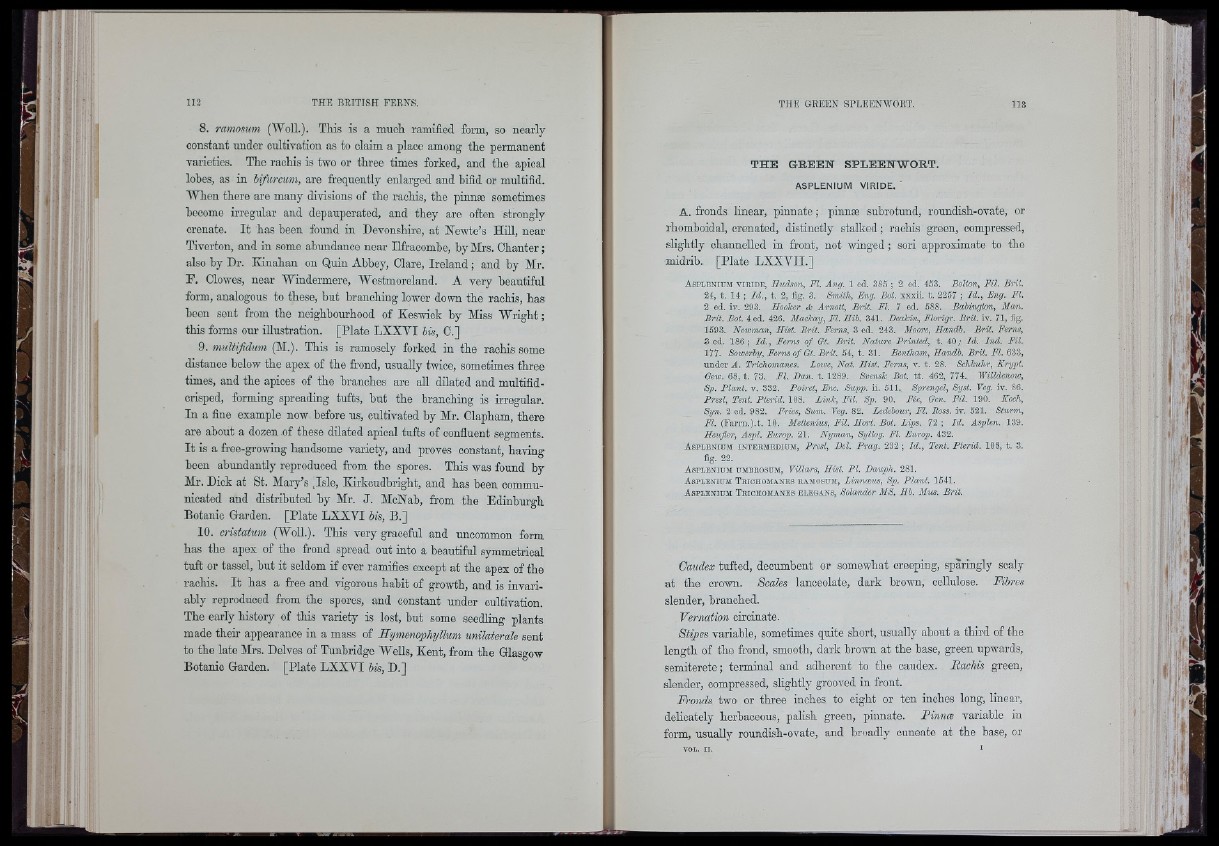
i
112
8. ramosum (Woll.). This is a much ramified form, so nearly
constant under cultivation as to claim a place among the permanent
varieties. The raohis is two or three times forked, and tho apical
lobes, as in Ufurcum, are frequently enlarged and bifid or multifid.
IVhon there aro many divisions of the raohis, the pinnæ sometimes
bocomo ii'regular and depauperated, and they aro often strongly
crenate. It has been found in Devonshire, at Newte’s Hill, near
Tiverton, and in some abundance near Ilfracombe, by Mrs. Chanter ;
also by Dr. Kinahan on Quin Abbey, Clare, Ireland ; and by Mr.
F. Clowes, near Windermere, Westmoreland. A very beautiful
form, analogous to these, but branching lower down the raohis, has
been sent from the neighbourhood of Keswick by Miss Wright ;
this forms our illustration. [Plate LXXVI Us, C.]
9. multifidum (M.). This is ramosely forked in the rachis some
distance below the apex of the frond, usually twice, sometimes three
times, and tho apices of the branches are aH dilated and multifid-
crisped, forming spreading tufts, but the branching is irregular.
In a fine example now before us, cultivated by Mr. Clapham, there
are about a dozen of these dilated apical tufts of confluent segments.
It is a free-growing handsome variety, and proves constant, having
been abundantly reproduced from the spores. This was fonnd by
Mr. Dick at St. Mary’s Jsle, Kirkcudbright, and has been communioated
and distributed by Mr. J. MoNah, from the Edinburgh
Botanic Garden. [Plate LXXVI Us, B.]
10. cristatum (Woll.). This very graceful and uncommon form
has the apex of the frond spread out into a beautiful symmetrical
tuft or tassel, but it seldom if ever ramifies except at the apex of the
raohis. It has a free and vigorous habit of growth, and is invariably
reproduced from the spores, and constant under cultivation.
The early history of this variety is lost, but some seedling plants
made their appearance in a mass of Hymenophyllum unilaterale sent
to the late Mrs. Delves of Tunbridge Wells, Kent, from the Glasgow
Botanic Garden. [Plate LXXVI Us, D.]
THE GKBBN SPLEENWOET.
ASPLENIUM VIRIDE. '
A. fronds Hnear, pinnate ; pinnæ suhrotund, roundish-ovate, or
rhomhoidal, crenated, distinctly stalked ; raohis green, compressed,
slightly channelled in front, not winged ; sori approximate to the
midrib. [Plate LXXVII.]
A s p l e n iu m v in id e , Hudson,, FI. Ang. 1 ed. 385 ; 2 ed. 453, Bolton, Fil. Brit.
2 i, t. 14 ; Id ., t. 2, fig. 3. Sinitli, Eng. Bot. x sxii. t. 2257 ; Id ., Eng. FI.
2 ed. iv. 293. Hooker ¿2 Arnott, Brit. FI. 7 ed. 588. Bahington, Man.
Brit. Bot. 4ed. 426. Mackay, FI. Hih, 341. Deakin, Florigr. Brit. iv. 71, fig.
1593. Newman, Hist. Brit. Ferns, 3 ed. 243. Moore, Handh. Brit. Ferns,
S ed. 1 86; Id ., Ferns o f Gt. Brit. Nature Printed, t. 4 0 ; Id . In d . Fil.
17 7 . Sowerhy, Feins o f Gt. Brit. 54, t. 31. Bentham, Handh. Brit. FI. 633,
under A . Trichomanes. Lowe, Nat. Hist. Ferns, v. t. 28. Schkuhr, Krypt.
Gew. 68, t. 73. FI. Dan. t. 1289. Svensk Bot. tt. 462, 774. Willdenow,
Sp. Plant. V. 332. Poiret, Enc. Supp. ii. 511. Sprengel, Syst. Veg. iv. 86.
Presl, Tent. Pterid. 108. L in k , Fil. Sp. 90. Fée, Gen. Fil. 190. Koch,
Syn. 2 ed. 982. Fries, Sum. Veg. 82. Ledebour, FI. Boss. iv. 521. Sturm,
FI. {Farm.).t. 10. Mettenius, Fil. Hort. Bot. Lips. 72 ; Id . Asplen. 139.
Heufler, Aspl. Europ. 21. Nyma n , Sijllog. FI. Europ. 432.
A s p l e n iu m in t e r m e d iu m , Presl, Del. Prag. 2 3 2 ; Id ., Tent. Pterid. 1 0 8 , t. 3.
fig. 22.
A s p l e n iu m UMBROSUM, Villars, Hist. PI. Dauph. 2 8 1 .
A s p l e n iu m T r ic h o m a n e s r a m o s u m , Linnoeus, Sp. P lant. 1 5 4 1 .
A s p l e n iu m T r ic h o m a n e s e l e g a n s , Solander MS. Hb. Mus. Brit.
Caudex tufted, decumbent or somewhat creeping, sparingly scaly
at the crown. Scales lanceolate, dark brown, cellulose. Fibres
slender, branched.
Vernation circinate.
Stipes variable, sometimes quite short, usually about a third of the
length of the frond, smooth, dark brown at the base, green upwards,
semiterete; terminal and adherent to the caudex. Rachis green,
slender, compressed, slightly grooved in front.
Fronds two or three inches to eight or ten inches long, linear,
dehoately herbaceous, palish green, pinnate. Pinnce variable in
form, usually roundish-ovate, and broadly cuneate at the base, or
■i 'i
I- :
illj
I iii Hi
I
*1
f t
i'd